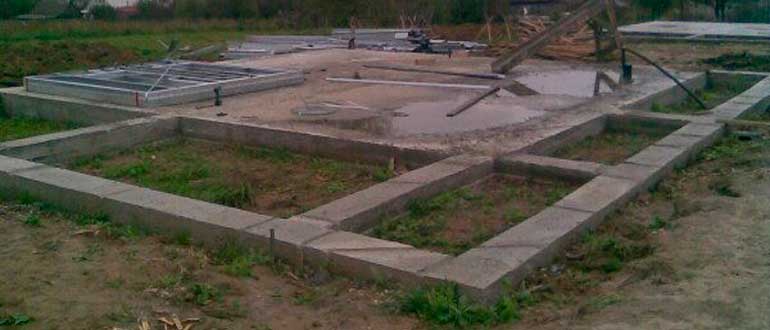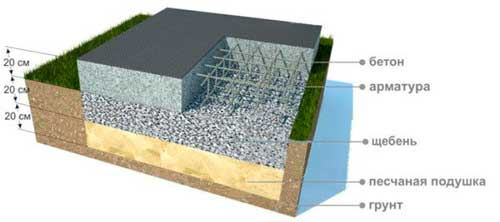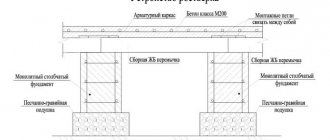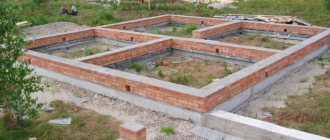What kind of foundation is needed for a house made of foam blocks?
In the process of building a house, every stage is important. This statement takes on particular significance when it comes to the foundation. It is the foundation laid for the future building that is one of the most important elements of the overall design. The foundation must take over and compensate for all the negative factors that are concentrated in the soil, and become a reliable base for the construction of the building.
The cheapest foundation for a house.
One should not think that lightweight wall materials, which include foam concrete, do not require special attention. A house made of foam blocks has specific characteristics, such as fragility, and they cannot be ignored. Therefore, the foundation base for such a structure must provide a perfectly level base. But due to the fact that the recommended height of a foam block house is no more than 3 floors, and cellular concrete itself is a lightweight wall material, there is no need to weigh down the foundation. This will have a positive impact on the overall construction cost.
Experts highlight the following as the best options for a house made of foam blocks:
- tape (depth depends on soil characteristics);
- columnar;
- monolithic slab.
The pile type of foundation is rarely used.
Choosing a foundation for a house made of foam concrete blocks.
In order to correctly determine the appropriate type of foundation base, you need to take into account the following parameters:
- soil characteristics;
- number of storeys;
- climatic conditions;
- construction time;
- financial opportunities.
The decisive factor influencing the choice of an individual developer is the soil on the site. It is advisable to analyze the soil for its type and chemical composition. It is also necessary to determine the level of freezing in winter and the location of groundwater. Without these studies there is no point in starting construction.
Of course, the price for the services of organizations conducting soil analysis will cost a pretty penny, but in problem areas it is better to pay the specified amount and build the correct foundation than to then constantly spend money on major repairs.

The cheapest foundation for a house made of foam blocks.
What does the soil hide?
- Close location of groundwater.
- Flowability.
- Difficult terrain.
- Water saturation (“wet” soil).
In each of the above cases, a balanced approach is needed. You cannot rely on the experience of neighbors on the site, because even 20 m between buildings is a decent distance, and the soil may have completely different characteristics. When starting construction, the owner must personally conduct research on which foundation is best for a house made of foam blocks. To do this, one or two wells are drilled to a depth of 2 m exactly on the site where the house will be located. Soil samples are taken every 20-25 cm.

The cheapest foundation for a house made of foam blocks.
The relationship between soil type and foundation type. On non-heaving (slightly heaving) soils, where the freezing depth does not exceed 1 m, and groundwater is below 2 m underground, a shallow strip-type foundation is selected and installed. If the water is located higher, then there is a need for drainage measures, which significantly increases the cost of the foundation.
It is known that the belt type loses a percentage of reliability in direct proportion to the groundwater level. If the indicator is only 0.5 m, then a foam block house will need a foundation in the form of an unburdened reinforced concrete slab. This design resists heaving and soil heterogeneity and evenly distributes the loads from a building of 2-3 floors onto the ground. The slab foundation protects the walls from cracks and the openings from deformation. A popular modern option is the Swedish stove. This is an insulated type of base, designed specifically for foam concrete blocks. The warranty period is 100 years.
A house on clay soil requires a columnar foundation underneath. A similar type is needed on peat-type soils and loams. If the non-heaving layers lie deep (2 m or more) or the area has complex terrain, a pile foundation will be required. The piles are mounted at intervals of 1 m, then it is necessary to perform a good monolithic piping. Pile foundations are installed for small buildings. Mostly these are one-story cottages, less often – houses with two floors. A foundation on screw piles is quite expensive compared to a traditional strip foundation, but in some situations you cannot do without it.

The cheapest foundation for a home with your own hands.
Technologies and construction timeframes.
The cheapest arrangement option. For such a base, a flat area with water depths of 2 m or more is suitable. Trenches can be dug manually to a depth of only 0.5 m. The height difference is checked with a water level. The width of the tape should be 10 cm larger than the future walls.
A cushion of sand and gravel (crushed stone) is formed at the bottom of the trench. The sand and gravel base of the foundation must be well compacted to prevent subsidence. Next, the formwork is created and reinforcement Ø10 mm is laid. Concrete is poured in one go.
The foundation must stand for at least 10 days, only after that can you begin laying the walls. But it is better if the foundation hardens for the required 28 days (4 weeks).
Well suited for a house with a basement. Compared to the previous type, it requires more consumables. Otherwise, the arrangement technologies are very similar.
It is used on clay, peaty, heaving soils, as well as when the soil freezing level is from 1.5 m. The height of the pillars must be at least 1 m and correspond to the freezing depth. Reinforced concrete supports are mounted in the corners of the building, at points of greatest load, under load-bearing walls. The standard distance between posts varies in the range of 1.5-2 m.
This option has an undeniable advantage - the shortest construction time. It is quite possible to complete all the work in 3-4 days, but provided that the height of the building is one floor. For more bulky buildings, the time frame will be increased due to the need for grillage.

An approximate diagram of the construction of the cheapest foundation for a house made of foam blocks.
It is also called a floating foundation. This type of foundation can be installed on any soil except clay. The rigidity of the structure is achieved through reinforcement. The depth of the foundation depends on the project (house with or without a basement). An important point is waterproofing. In most cases, this type of foundation is performed by a team of specialists on a turnkey basis. The disadvantages are the long hardening time and significant financial costs for materials.
A house built from foam blocks, although lightweight, requires the right foundation. In recent years, builders have decided that the best foundation on sandy soil (after slab) is a pile foundation. The piles are quickly installed. They are an excellent solution for relief areas with problematic soil.
The pile foundation for foam concrete blocks, regardless of the type of supports used (hanging, screw or rack piles), is strengthened with a grillage. Of course, this increases the cost of construction. The obligatory hiring of a team of specialists with equipment can also be considered a disadvantage.
Prices for turnkey foundation installation.
By ordering a service from an organization that deals with foundations, the developer ideally receives an excellent foundation for a future house made of foam blocks. At the same time, the owner of the site does not delve into the technology, relying on the experience of professionals.
The brigade undertakes:
- site preparation;
- delivery of necessary materials;
- excavation;
- marking;
- installation and dismantling of formwork;
- reinforcement;
- concreting;
- backfill.
Companies use various methods to set prices for their services. Calculations are used per 1 m2, per 1 m3 or per 1 linear meter. Installation of piles is estimated individually; on a large site, a system of discounts is usually provided.
The cheapest foundation for a house made of foam blocks.
How much will the work of specialists cost:
Which foundation is better for a house made of foam blocks: pile, strip or monolithic.
So, we decided that our house would be built from foam blocks. It's a promising start, especially considering how much good there is to say about this material.
However, as soon as we are ready to start creating a project and calculating estimates, the question of the foundation arises.

The cheapest foundation for a house made of foam blocks.
Photo of a light version of the base.
How to calculate the load

The load on a supporting structure made of foam blocks can be calculated using a special formula, the components of which are the following values:
- Base area (S, cm2).
- Weight of the future house (F, kg).
- Soil resistance coefficient (R0).
- Material strength coefficient (Yn).
- Climate conditions coefficient (Yc)/
The formula itself looks like:
We choose the best option for the basis for the house.
What kind of foundation is needed for a foam block house that will be most rational to use? Here we will immediately disappoint many - there is no universal answer to this question. There are several options, both the base itself and the selection parameters.
Let's immediately define two directions in which we will consider options:
- Soil type. In any case, we will have to build on this in foundation work.
- Building type. But rather the load that this building will exert on the foundation.
Problematic soil.
And we will start our conversation from the ground. Before starting work, we will definitely need to conduct a geological analysis of the soil at the construction site. (see also the article Do-it-yourself country house made of foam blocks - we build it simply and quickly)
Based on its results, it will be possible to draw the first conclusions.
So, what problems can the soil hide:
- Flowability . This is a weak type of soil, in which we may experience skewing and subsidence of the building from one of the corners. As a result, serious deformations of the base and walls themselves.
- Water saturation . This suggests that when making a foundation for a house made of foam blocks, we will have to carry out large-scale drainage work, which will not be limited to draining water only during construction. The drainage system will have to work afterwards.
- High groundwater table . The difference from water-saturated soil is that here water will wash away the base and destroy it.
- Difficult terrain . This moment can also be displayed in the area of the problematic soil. In any case, with such a terrain it is quite difficult to build a classic strip foundation, for example.

Solving the issue with the relief.
This is the main point in the development of any foundation, because, in fact, the foundation is a supporting structure that takes on the loads of the building and distributes them, releasing them to the soil.
The instructions for creating any foundation always assume that all loads will be collected, that is:
- Wall weight.
- Roof weight.
- Floor weight.
- Household appliances and utilities.
- Weight of all proposed occupants.
- Variable loads.
Based on these two parameters, we draw a conclusion about what kind of foundation is needed for a house made of foam blocks.

The cheapest foundation for a house.
Foundation for a foam block house.
Pile type.
The pile base is perfect for foam block construction due to several points:
- Relatively cheap with excellent quality.
- Short construction time.
- Possibility of installation on problematic soils.
- Possibility of independent construction.
To consolidate all the above advantages, we suggest considering the option with bored piles, which we will step by step lead to the foundation for our foam block house. (see also the article House for a summer residence made of foam blocks - a very interesting option)
- Site marking.
- Drilling of the wells. A hand-held hole drill is also suitable for this, since the depth should be at the freezing level, which is a maximum of one and a half meters.
- Well expansion. Filling the cushion with sand and compacting it.
- Installing a glass can be made from simple roofing felt.
- Immersion of the reinforcing element.
- Pouring concrete.

Bored base with grillage.
As you can see, there is nothing complicated in the design of such a basis. The main thing will be to strictly adhere to the design requirements. And this is the number of piles and their location.
And after the piles are filled, we have two options:
- Create a grillage and fill it with foundation.
- Place monolithic slabs on top.
In principle, we can only build a grillage with our own hands; special equipment will be required for the slabs.
Advice! To make the grillage even more durable than even originally planned, you can increase the cross-section of the reinforcement and use granite rather than the usual limestone type of crushed stone in the concrete batch.

This was the first version of the base structure.
Tape base.
And here is our tape base. Often, when asked what kind of foundation to make for a house made of foam blocks, the answer follows precisely the theme of the strip type. (see also the article Projects of country houses made of foam blocks: features of design and project selection)
Indeed, this is one of the simplest types of foundation that we can easily build with our own hands.
If the soil and the project allow, then step by step everything looks like this:
- Marking the foundation.
- Excavation. Depending on the size, you can dig everything up yourself, or you can rent a small excavator.
- Laying sand at the bottom of trenches and compacting.
- Laying the reinforcing element.
- Installation of formwork.
- Pouring concrete.

Trench and reinforcement.
There are also some interesting nuances here. Firstly, we will need to take care of waterproofing. To do this, after removing the formwork, we treat the concrete with mastic. This is the simplest and most affordable version of waterproofing.
We always suggest using reinforcement with a certain margin of safety. Of course, the price increases somewhat, but still we are talking about creating a foundation.
Speaking of materials, there is nothing unusual here. However, returning to waterproofing, you can use liquid glass in the concrete batch; this material will also significantly increase the water resistance of the base.
When installing formwork, it would be more rational to use construction moisture-resistant plywood, which can then be used in a variety of jobs. And during the fastening process, wood screws are excellent. They connect the parts of the formwork better and are much easier to dismantle.
Another type of foundation that we can also quite successfully use is a monolithic slab. Moreover, it can be either a simple monolith or a Swedish stove, in which we will immediately arrange communications.
In this case, the question of which foundation to choose for a house made of foam blocks depends rather on the functional component of the monolith and the cost. Let's consider the basic principles of the monolith design:

Monolithic foundation for a foam block house.
Monolith for a foam block house.
- Excavation. If the pit is in a water-saturated area, then drainage work is necessary. We definitely can’t do without an excavator here.
- Compacting a sand cushion. If we assume a Swedish stove, then we also level the bottom of the pit.
- We install waterproofing. This is either roofing felt or dense polyethylene. Moreover, we install everything in several layers.
- We used a Swedish stove and installed thermal insulation boards.
- We knit the reinforcement. For the monolithic type, we choose reinforcement with a cross-section of 12-14 cm, and knit it in increments of 15-20 cm.
Here is a lyrical digression. Before making a foundation for a house made of foam blocks, we calculate all the loads, and accordingly we can accurately select the required reinforcement section.
How important is it to choose it with a margin of safety? In principle, no one forbids us to do this, the main thing is not to choose a smaller section.
Important! The reinforcement should be positioned taking into account the outlet at the edges, where it bends and will be connected to the walls.
In addition, even if we install it in one horizontal row, we will have to raise it so that it is approximately in the middle of the slab. To do this, we install it on special supports.
- We install the formwork.
- We fill everything with concrete.
The monolithic slab is ready.

An approximate diagram of the construction of the cheapest foundation for a house made of foam blocks.
Approximate diagram of the foundation structure.
Important! If we have a Swedish stove, all communication pipes or heated floors are filled with air before pouring concrete, so it will definitely not deform under the weight of the concrete.
So, we answered the main question, what kind of foundation is needed for a house made of foam blocks, giving an example of three main types of foundation that can fully meet all the requirements of a house made of foam blocks.
In addition, these types of foundations can be selected depending on the condition of the soil at the construction site, that is, we have several options. And this always means more opportunities.
Let’s not forget about the financial component; foam blocks initially save some costs, so you can optimize the foundation of the house. In the video presented in this article you will find additional information on this topic.
Conclusion
So, we answered the main question, what kind of foundation is needed for a house made of foam blocks, giving an example of three main types of foundation that can fully meet all the requirements of a house made of foam blocks.
In addition, these types of foundations can be selected depending on the condition of the soil at the construction site, that is, we have several options. And this always means more opportunities.
Let’s not forget about the financial component; foam blocks initially save some costs, so you can optimize the foundation of the house. In the video presented in this article you will find additional information on this topic.
Tip 1: What kind of foundation is needed for a house made of foam blocks.
Choose the foundation that is optimal for your conditions, taking into account all possible factors. Usually these are the characteristics of the soil, the number of floors of the future house, its size according to the project.
Check the composition of the soil in the area. intended for construction. If there is a large amount of clay, loam or peat, this means that the soil is very weak. In this case, arrange a columnar foundation for a house made of foam blocks. Use it even if the soil is heaving.
Place reinforced concrete pillars in the corners of the façade. in places where load-bearing walls will be erected, in places of heavy load. Maintain a depth of at least a meter. Maintain a distance of one and a half to two meters between the pillars. Attach the reinforcement cage using tying wire to the mounting loops on the posts. The rods should be 8 mm in diameter, concrete grade M200.
Determine the depth at which groundwater is located. If their depth is more than three meters, a shallow strip foundation is perfect. It will require a trench 50 centimeters deep, which is dug along the perimeter of the future foam block structure and under the designed load-bearing walls. Arrange the base so that it is 10 centimeters wider than the walls. Place a cushion of crushed stone and sand on the bottom. Each layer should be 100 mm thick. Install the formwork and lay the two-layer reinforcement cage. For it, the rods must have a diameter of 10 mm. Concrete pouring will need to be done once, filling the entire trench at once.
If your site has a different type of soil, a monolithic slab foundation may be better than other options. It can be installed on any type of soil, except clay. Such a foundation is called floating - its design is such that the foundation can move along with the ground. At the same time, the walls of the future house made of foam blocks receive good protection from damage and cracks. You will need to build a pit under the entire area that the house will occupy according to the project. Its depth should be 60 cm. More than half of this will be used for the pillow - 25 cm of the pit should be occupied by a layer of sand, 15 cm by a layer of crushed stone. After this, install waterproofing and a frame made of reinforcement. It must be composed of two layers of reinforcement, the diameter of which is 8 mm; keep a step of 25 cm between the rods.
Disadvantages of a foam block foundation
Despite the sufficient strength of foam concrete as a building material, it has significant disadvantages. The fact is that this material absorbs moisture very abundantly and is capable of deteriorating layer by layer over time. A foam block supporting structure, even if carefully created with your own hands, will not be able to withstand unstable climatic conditions. Watch the video on how to properly build a foundation from foam blocks.
Of course, problems can be reduced by high-quality waterproofing and a small load on such a foundation. But this can be a big problem for inexperienced builders who decide to build a home with their own hands. Another important disadvantage of using foam concrete for foundations is its low frost resistance.











